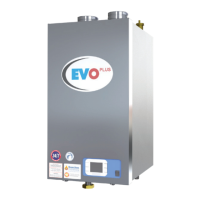39
PART 7. SERVICING
C. EVO SOFT LOCKOUT CODES
TABLE 71 CCB SOFT LOCK OUT SLO CODES
TABLE 72 BCB SOFT LOCK OUT SLO CODES
*Codes may appear with an A, B, or C as a sux denoting the number of times the code has appeared since the
last Initialization (INI). Some SLO’s are accompanied by a reduction of the maximum firing rate; A=80%, B=50%,
C=30%. After the C sux appears, the next code of that kind becomes an HLO (manual reset required).
Code Cause Recommended Action
CCB01 Sensor S1 fault Check that the S1 sensor is connected
CCB02 Sensor S2 fault Check that the S2 sensor is connected
CCB03 Sensor S3 fault Check that the S3 sensor is connected
CCB04 Sensor S4/SZ1 fault Check that the S4/SZ1 sensor is connected
CCB05 Sensor S5/SZ2 fault Check that the S5/SZ2 sensor is connected
CCB06 Sensor S6 fault Check that the S6 sensor is connected
CCB07 Sensor SZ3 fault Check that the SZ3 sensor is connected
CCB08 Sensor zone 4 fault Check that the zone 4 sensor is connected
CCB09 Sensor zone 5 fault Check that the zone 5 sensor is connected
CCB10 Sensor zone 6 fault Check that the zone 6 sensor is connected
CCB11 Sensor zone 7 fault Check that the zone 7 sensor is connected
CCB12 Sensor zone 8 fault Check that the zone 8 sensor is connected
CCB15 Communication error via Modbus programming Quantity of programmed appliances does not match quantity of connected appliances.
CCB20-
CCB27
Communication error with a specic appliance;
A = CCB 20… H = CCB 27
Check specic appliance to see that it is powered on, if yes, then check all communication connections at display and
main boards
CCB200 EEPROM fault Check that the EEPROM is connected properly
Code Cause Recommended Action
A1* Excessive pressure differential (∆P) on water side of heat exchanger Check for scaling or blockage on water side of heat exchanger, also check pump performance. If
this SLO is indicated while the unit is ring, it is doing so at a reduced BTU input; low enough to stay
below that maximum ∆P set point.
B01 Pressure too high at condensate drain connection during Stand By Look for condensate backing up into combustion side of heat exchanger.
B02 Pressure too high at condensate drain connection during pre-purge Insure condensate drain system is owing freely, and vent is clear of obstructions. Also, be sure the
Z-INI has been initiated.
B03 Pressure too low at condensate drain connection during pre-purge Check for condensate (water) in the condensate neutralizer (if equipped) or the condensate trap
at appliance outlet. If it is dry, add water to form trap. The appliance also will initiate an auto-lling
process for the condensate trap, indicated on the screen during this operation. Also, be sure the
Z-INI has been initiated.
B04 Pressure at ue/condensate sensor is too low Check ue gas vent connection or sensor connection located at condensate drain line. Also check
for a disconnected or open condensate drain line and last, look for a leak in the heat exchanger
outer casing (behind the insulation).
DW7* Temperature rise (∆T) through heat exchanger is too high Unit is operating at a reduced BTU input - check for scaling or blockage on water side of heat
exchanger, also check pump performance.
FL05* Flue gas temperature too high Unit is burning at a reduced BTU input rate. The cause of the high ue gas temperature should be
investigated and corrected ASAP
FL09* Fouling of the re side of the heat exchanger Unit is burning at a reduced BTU input rate. A combustion side inspection and cleaning should be
scheduled ASAP.
FL13 Flue gas sensor (T5) fault (not connected or open status) Check the condition of the connectors and wires from the card edge connector at the board to the
ue gas sensor on the appliance.
FL14 Flue gas sensor (T5) fault (short circuit status) Take an OHM reading at the connector on the ue gas sensor - compare it to the chart on page 47
replace if out of range.
G01* Gas supply pressure too low If this occurs at the beginning of an ignition cycle, this SLO will stay until the pressure is high enough
for proper ignition. If this occurs while the unit is ring, and it continues to re, it is doing so at a
reduced BTU input low enough to stay above that minimum pressure set point.
H01 Outlet sensor (T1.1, 1.2) fault (not connected or open status) Check the condition of the connectors and wires from the card edge connector at the board to the
outlet sensor on the appliance.
H02 Inlet sensor (T2) fault (not connected or open status) Check the condition of the connectors and wires from the card edge connector at the board to the
inlet sensor on the appliance.
H04 Outlet sensor (T1.1, 1.2) fault (short circuit status) Take an OHM reading on the outlet sensor - compare it to the chart on page 47 replace if out of
range.

